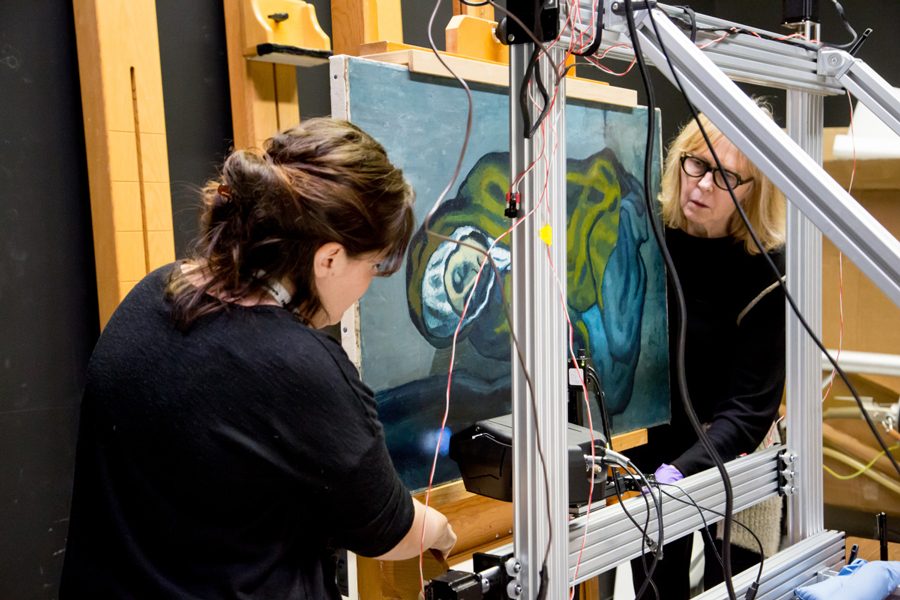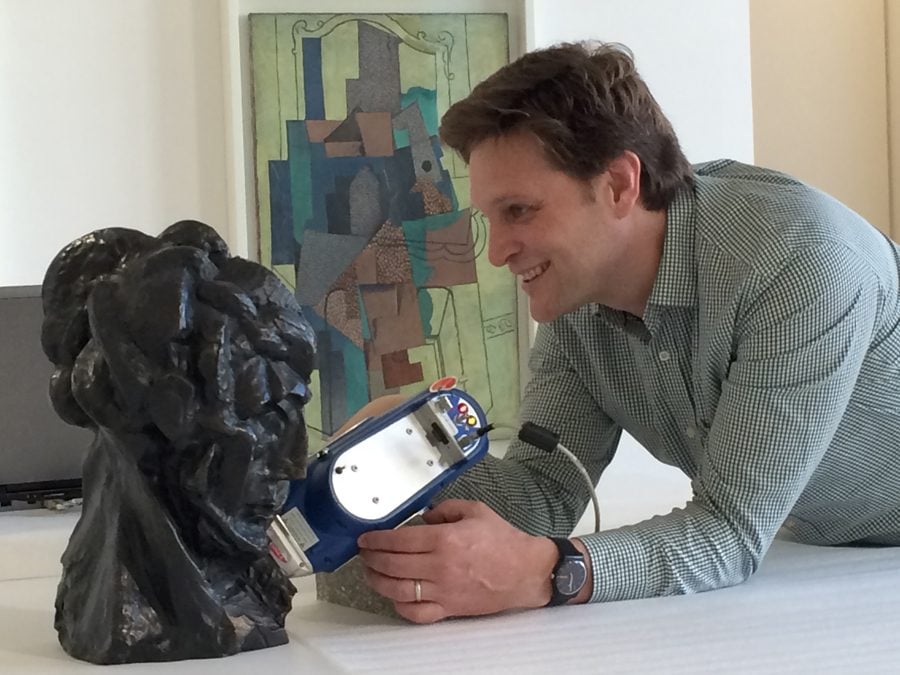NU researchers reveal details about Picasso’s artistic style after making new discoveries in bronzes, painting
Source: RMN-Grand Palais (Musée national Picasso-Paris), Succession Picasso 2018
Marc Walton uses a portable instrument to analyze the alloys of Picasso’s bronzes. Walton and other NU-ACCESS researchers discovered that five of Picasso’s bronzes were created at the foundry of Émilie Robecchi.
February 22, 2018
Using novel techniques in imaging and X-ray radiography, Northwestern researchers discovered that five of Pablo Picasso’s bronzes can be traced to the foundry of Émilie Robecchi, one of his lesser-known collaborators.
The bronzes were created during the Nazi occupation of Paris when the majority of the city’s metal supply was reserved for the war, said Marc Walton, co-director of Northwestern University/Art Institute of Chicago Center for Scientific Studies in the Arts.
“It adds into this overall story of Picasso thumbing his nose at the Nazis and going ahead and doing these castings, even though there was a ration of metals,” Walton said. “It’s this sort of information that we can get out of the analysis to build the larger story about how the artist was working at a particular time period and what the overall socioeconomic situation might have been for these bronzes.”
Walton, NU-ACCESS co-director Francesca Casadio, and postdoctoral fellows Emeline Pouyet and Gianluca Pastorelli were part of the team that revealed information about Picasso’s artistic style after discovering the history behind the bronze casts and a landscape hidden underneath his Blue Period “La Miséreuse accroupie.”
NU-ACCESS created an X-ray fluorescence scanner to analyze the elemental distribution of various pigments of the painting. This information complemented information from hyperspectral imaging done by John Delaney, a senior imaging scientist at the National Gallery of Art in Washington.
The researchers worked with the Art Gallery of Ontario and the National Gallery to analyze the painting and bronzes using these instruments, revealing their collaborated research on Saturday.
While analyzing the painting “La Miséreuse accroupie,” they discovered the hidden landscape, which Picasso rotated 90 degrees and incorporated into his own work by turning the lines of the cliff edges into a woman’s back. They also discovered that Picasso had originally painted the woman’s right arm, but later covered it with the cloak in the final version.

Northwestern researcher Emeline Pouyet and Sandra Webster-Cook of the Art Gallery of Ontario use the X-ray fluorescence instrument to scan “La Miséreuse accroupie.” The X-ray fluorescence technology revealed details about a landscape hidden beneath the painting.
These details revealed that while Picasso’s Blue Period paintings might look simplistic with their monotone palettes, they actually include complex layers of “different shapes and forms that are being layered on top of one another,” Walton said.
“In our analysis techniques, it allows us to probe that (idea), giving us different information about how and when he made those decisions along the way,” Walton said. “In that sense, we’re getting into the mind of the artist, understanding how he is taking the creative process.”
Art History Prof. Christina Kiaer, who specializes in global modern and contemporary art in Europe, said if she were to teach “La Miséreuse accroupie,” she would emphasize the “flatness” of it, but would also question why the painting looks the way it does.
“This material science, I imagine, is an aid to show part of the reason this line is curved is because he was looking at the landscape and saw the curves and thought, ‘This could work well for this picture I have in mind,’” Kiaer said.
Walton said the team plans to analyze Picasso’s “La Soupe” as the next step in its research, which will be presented at the annual American Institute of Conservation meeting June 1. For the bronzes, Pouyet said the plan is to “create a database of bronzes in the 20th century” using this same technology.
The details uncovered by the further research will be revealed in a Picasso Blue Period exhibition at the Art Gallery of Ontario and The Phillips Collection in Washington, D.C. from 2020 through 2021, according to a Saturday news release.
The portable imaging technology opens up new opportunities for scanning other artists’ paintings, as current imaging techniques are typically only used at national facilities, Walton said.
“To travel a work of art to one of these national facilities is difficult because museums don’t want to move their paintings,” Walton said. “It’s expensive. It’s potentially damaging … We’ve made an inexpensive way of being able to bring that technology to the paintings, which opens up new possibilities to scanning many more paintings.”
Email: alliegoulding2020@u.northwestern.edu
Twitter: @alliejennaphoto



